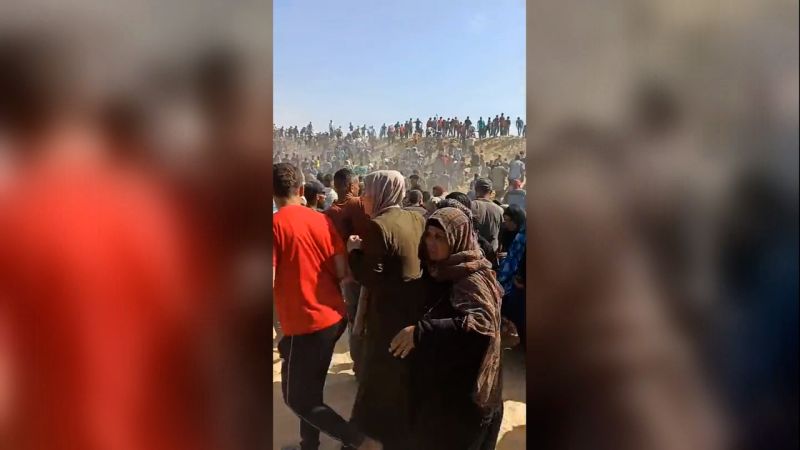Chaos erupted at an aid distribution site in Gaza operated by a controversial US-backed organization, triggering a distressing scene as thousands of desperate Palestinians scrambled for food supplies. The tumultuous event unfolded with Israeli troops firing warning shots into the air, prompting the US contractors managing the site to temporarily withdraw.
The crisis stemmed from an 11-week Israeli blockade on humanitarian aid, exacerbating the plight of over 2 million Palestinians in Gaza, pushing them towards famine and escalating the region's humanitarian crisis. Last week marked the initial trickle of humanitarian aid into the besieged enclave following the protracted blockade.
Videos captured at the distribution site in Tel al-Sultan, overseen by the Gaza Humanitarian Foundation cGHFc, depicted large crowds surging towards the facilities, breaching fencing, and surmounting barriers erected to manage the crowd's flow. Tragically, Palestinian health officials reported one fatality and 48 injuries during the chaotic distribution, with one individual succumbing to severe injuries at the Red Cross Field Hospital in Rafah.
Wafiq Qdeih, present at the site in hopes of securing aid, highlighted the desperation prevailing among the affected populace, noting the challenges in maintaining order amid the dire need for sustenance. The Israeli army's intervention, marked by gunfire and the withdrawal of American personnel overseeing the site, further complicated aid distribution efforts, leaving many clamoring for assistance.
Among those seeking aid, stories emerged of gratitude for the provisions received but also narrations of enduring arduous journeys to reach the distribution center, enduring lengthy queues, and grappling with overarching confusion in the process. The site's conditions evoked a mix of relief for the aid received and exhaustion from the challenging circumstances faced by the affected individuals.
The GHF acknowledged the disorder at the site, justifying their retreat to ensure the safe retrieval of aid by a limited number of Palestinians in adherence to their operational protocols aimed at preventing casualties. While the chaos unfolded, conflicting reports emerged regarding the involvement of American security contractors on-site, with some sources denying any gunfire and outlining plans for resuming operations post the tumultuous episode.
Following the disturbance, insights emerged from diplomatic officials and aid experts, characterizing the incident as a predictable outcome amidst the region's worsening humanitarian crisis. Concerns were voiced about the effectiveness and ethical implications of aid distribution strategies underpinning the GHF's operations, underscored by the organization's ambition to ramp up aid delivery to a significant portion of Gaza's population.
However, scrutiny mounted over the GHF's operational transparency and outreach strategies, notably the absence of distribution sites in northern Gaza. Criticism from aid experts and international bodies underscored the imperative of ensuring equitable access to aid across all regions of Gaza, thus mitigating concerns of favoritism or strategic isolation of populations within the enclave.
Conversely, geopolitical tensions loomed large on the horizon, with Israel's military actions against Hamas continuing unabated, drawing condemnation from global allies and humanitarian agencies. Plans to further encroach upon Gaza's territory elicited apprehensions of displacing a significant share of the already vulnerable Palestinian population, raising alarms about the dire implications of such aggressive territorial strategies.
In the backdrop of escalating tensions and humanitarian crises, voices from the UN and humanitarian agencies echoed calls for a more coordinated, inclusive approach to aid distribution in Gaza, emphasizing the need for unrestricted access to essential supplies and a secure environment for humanitarian operations. Critiques mounted against the GHF's aid plan, labeling it a distraction from more pressing needs and urging a reevaluation of strategies to address the unfolding crisis effectively.
As the saga unfolds, the collaboration between Israel, the US, and humanitarian organizations in Gaza's aid distribution landscape remains a focal point of scrutiny and debate. The identity of the entities involved in aid operations, as evidenced by markings on aid boxes, sparks inquiries into their affiliations, operational modalities, and alignment with international humanitarian standards.
In conclusion, the distressing scenes at the Gaza aid distribution site underscore the complex interplay of geopolitical dynamics, humanitarian imperatives, and operational challenges in addressing the region's ongoing crisis. As stakeholders navigate the evolving landscape of aid provision in Gaza, the imperative remains to uphold humanitarian principles, ensure equitable access to aid, and foster a conducive environment for peace and stability in the beleaguered enclave.

